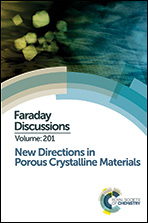Functionalized metal organic frameworks for effective capture of radioactive organic iodides†
Abstract
Highly efficient capture of radioactive organic iodides (ROIs) from off-gas mixtures remains a substantial challenge for nuclear waste treatment. Current materials utilized for ROI sequestration suffer from low capacity, high cost (e.g. use of noble metals), and poor recyclability. Recently, we have developed a new strategy to tackle this challenge by functionalizing MOF materials with tertiary amines to create molecular traps for the effective capture and removal of ROIs (e.g. radioactive methyl iodide) from nuclear wastes. To further enhance the uptake capacity and performance of CH3I capture by ROI molecular traps, herein, we carry out a systematic study to investigate the effect of different amine molecules on ROI capture. The results demonstrate a record-high CH3I saturation uptake capacity of 80% for MIL-101–Cr–DMEDA at 150 °C, which is 5.3 times that of Ag0@MOR (15 wt%), a leading adsorbent material for capturing ROIs during nuclear fuel reprocessing. Furthermore, the CH3I decontamination factors (DFs) for MIL-101–Cr–DMEDA are as high as 5000 under simulated reprocessing conditions, largely exceeding that of facility regulatory requirements (DF = 3000). In addition, MIL-101–Cr–DMEDA can be recycled without loss of capacity, illustrating yet another advantage compared to known industrial adsorbents, which are typically of a “single-use” nature. Our analysis also shows that both physisorption and chemisorption of CH3I occur at the three amine-grafted MOFs. While chemisorption takes place at the amine functionalized sites, the amount of physisorption correlates with the MOF porosity. A possible binding site of amine–CH3I interaction has been identified via an in situ IR spectroscopic study. The results suggest that CH3I interacts strongly and directly with the tertiary nitrogen of the amine molecules. The CH3I uptake amount decreases as the amine chain length increases, in trend with the decreasing pore space of the corresponding framework. The strategy to build MOF-based molecular traps developed in this work not only leads to a new record-high performance for ROI capture, but also offers an effective way of systematically tuning the porosity by varying the length of functionalized amine molecules. This study also demonstrates that MOFs represent a promising new platform for selective capture and removal of radioactive nuclear waste.
- This article is part of the themed collection: New directions in porous crystalline materials


 Please wait while we load your content...
Please wait while we load your content...